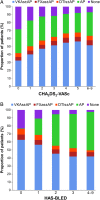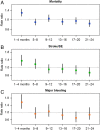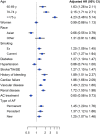Two-year outcomes of patients with newly diagnosed atrial fibrillation: results from GARFIELD-AF
- PMID: 27357359
- PMCID: PMC5070447
- DOI: 10.1093/eurheartj/ehw233
Two-year outcomes of patients with newly diagnosed atrial fibrillation: results from GARFIELD-AF
Abstract
Aims: The relationship between outcomes and time after diagnosis for patients with non-valvular atrial fibrillation (NVAF) is poorly defined, especially beyond the first year.
Methods and results: GARFIELD-AF is an ongoing, global observational study of adults with newly diagnosed NVAF. Two-year outcomes of 17 162 patients prospectively enrolled in GARFIELD-AF were analysed in light of baseline characteristics, risk profiles for stroke/systemic embolism (SE), and antithrombotic therapy. The mean (standard deviation) age was 69.8 (11.4) years, 43.8% were women, and the mean CHA2DS2-VASc score was 3.3 (1.6); 60.8% of patients were prescribed anticoagulant therapy with/without antiplatelet (AP) therapy, 27.4% AP monotherapy, and 11.8% no antithrombotic therapy. At 2-year follow-up, all-cause mortality, stroke/SE, and major bleeding had occurred at a rate (95% confidence interval) of 3.83 (3.62; 4.05), 1.25 (1.13; 1.38), and 0.70 (0.62; 0.81) per 100 person-years, respectively. Rates for all three major events were highest during the first 4 months. Congestive heart failure, acute coronary syndromes, sudden/unwitnessed death, malignancy, respiratory failure, and infection/sepsis accounted for 65% of all known causes of death and strokes for <10%. Anticoagulant treatment was associated with a 35% lower risk of death.
Conclusion: The most frequent of the three major outcome measures was death, whose most common causes are not known to be significantly influenced by anticoagulation. This suggests that a more comprehensive approach to the management of NVAF may be needed to improve outcome. This could include, in addition to anticoagulation, interventions targeting modifiable, cause-specific risk factors for death.
Clinical trial registration: http://www.clinicaltrials.gov. Unique identifier: NCT01090362.
Keywords: Anticoagulation; Atrial fibrillation; Bleeding; Stroke; Stroke prevention.
© The Author 2016. Published by Oxford University Press on behalf of the European Society of Cardiology.
Figures




Comment in
-
Atrial fibrillation: a risk factor or risk marker?Eur Heart J. 2016 Oct 7;37(38):2890-2892. doi: 10.1093/eurheartj/ehw313. Epub 2016 Jul 19. Eur Heart J. 2016. PMID: 27436866 No abstract available.
References
-
- Allender S, Scarborough P, Peto V, Rayner M, Leal J, Luengo-Fernandez R, Gray A. European cardiovascular disease statistics, 2008 edition. Brussels: European Heart Network; 2008.
-
- Schnabel RB, Yin X, Gona P, Larson MG, Beiser AS, McManus DD, Newton-Cheh C, Lubitz SA, Magnani JW, Ellinor PT, Seshadri S, Wolf PA, Vasan RS, Benjamin EJ, Levy D. 50 year trends in atrial fibrillation prevalence, incidence, risk factors, and mortality in the Framingham Heart Study: a cohort study. Lancet 2015;386:154–162. - PMC - PubMed
-
- Camm AJ, Lip GY, De Caterina R, Savelieva I, Atar D, Hohnloser SH, Hindricks G, Kirchhof P. 2012 focused update of the ESC Guidelines for the management of atrial fibrillation: an update of the 2010 ESC Guidelines for the management of atrial fibrillation. Developed with the special contribution of the European Heart Rhythm Association. Eur Heart J 2012;33:2719–2747. - PubMed
-
- January CT, Wann LS, Alpert JS, Calkins H, Cigarroa JE, Cleveland JC Jr, Conti JB, Ellinor PT, Ezekowitz MD, Field ME, Murray KT, Sacco RL, Stevenson WG, Tchou PJ, Tracy CM, Yancy CW, ACC/AHA Task Force Members. 2014 AHA/ACC/HRS guideline for the management of patients with atrial fibrillation: executive summary: a report of the American College of Cardiology/American Heart Association Task Force on practice guidelines and the Heart Rhythm Society. Circulation 2014;130:2071–2104. - PubMed
-
- Kakkar AK, Mueller I, Bassand JP, Fitzmaurice DA, Goldhaber SZ, Goto S, Haas S, Hacke W, Lip GY, Mantovani LG, Verheugt FW, Jamal W, Misselwitz F, Rushton-Smith S, Turpie AG. International longitudinal registry of patients with atrial fibrillation at risk of stroke: Global Anticoagulant Registry in the FIELD (GARFIELD). Am Heart J 2012;163:13–19 e1. - PubMed
Publication types
MeSH terms
Substances
Associated data
LinkOut - more resources
Full Text Sources
Other Literature Sources
Medical

